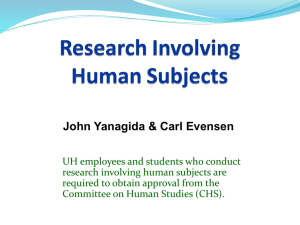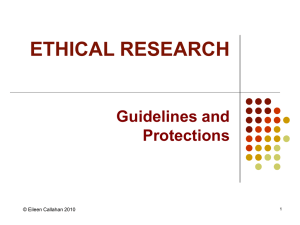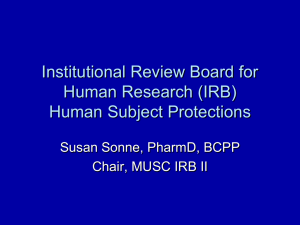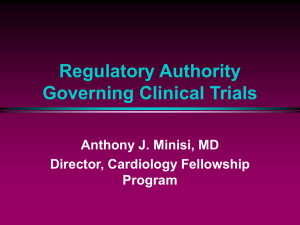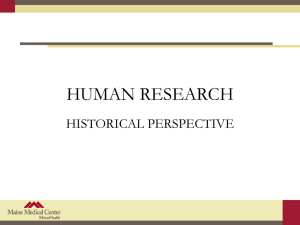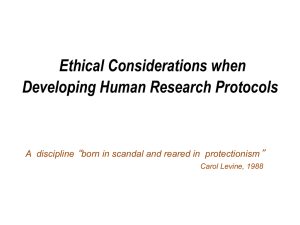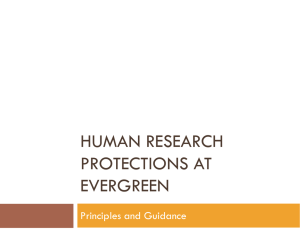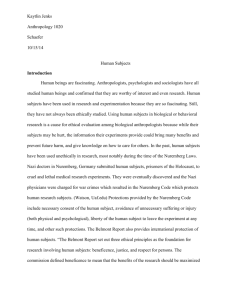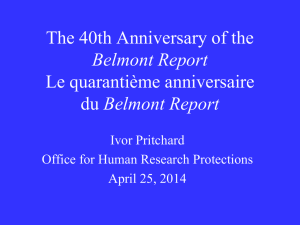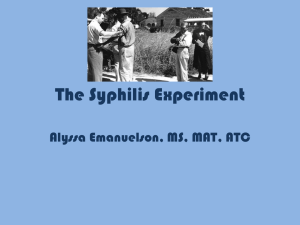Ethical Aspects of Clinical Research: IRB & Risk Assessment
advertisement
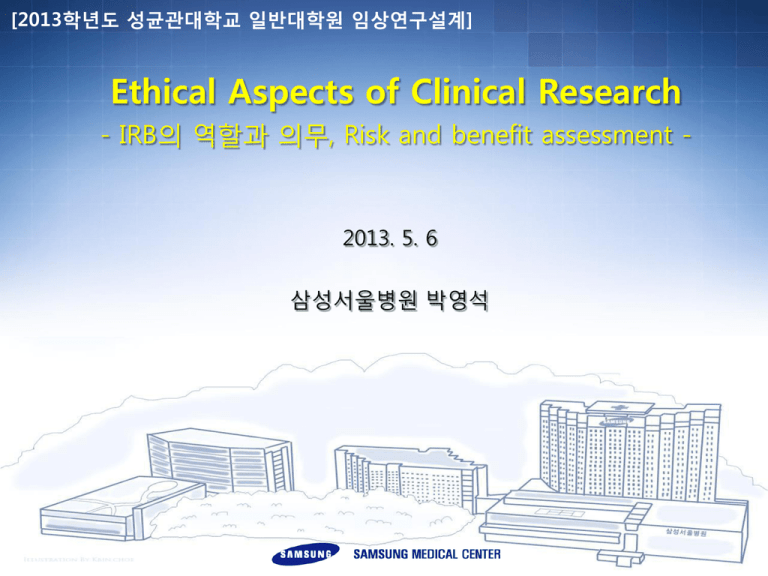
[2013학년도 성균관대학교 일반대학원 임상연구설계] Ethical Aspects of Clinical Research - IRB의 역할과 의무, Risk and benefit assessment - 2013. 5. 6 삼성서울병원 박영석 First Documented Human Subject Research • Edward Jenner (1749-1823) first tested smallpox vaccines on his son and on neighborhood children. • Johann Jorg (1779-1856) swallowed 17 drugs in various doses to record their properties. • Louis Pasteur (1822-1895) "agonized over treating humans," even though he was confident of the results obtained through animal trials. He finally did so only when he was convinced the death of the child, the first test subject, "appeared inevitable." 신농(神農)씨 • 고대 중국의 전설상의 제왕[天子] • 《제왕세기(帝王世紀)》 등에 의하면, 신농씨의 성은 강(姜)이며, 그 어머니는 유교씨(有嬌氏)의 딸로 소전씨(小典氏)의 아내가 되어 신룡(神龍)에게서 영감(靈感)을 얻어 인신우수(人身牛首)의 신농씨를 낳았다. 신농씨는 화덕(火德)을 가지고 있었기 때문에 염제(炎帝)라 하였는데, 나무를 잘라 구부려서 뇌사(耒耜:호미 같은 농구)를 만들어 백성에게 농경을 가르쳤으며, 백초(百草)를 맛보아 약초를 찾아내 치병(治病)하였고, 오현금(五絃琴)을 만들었으며, 팔괘(八卦)를 겹쳐 육십사효(六十四爻)의 점(占)을 보는 점술을 고안해냈고, 저자(시장)를 세워 백성들에게 교역을 가르쳤다고 한다. 즉 그는 중국의 농업 ·의약 ·음악 ·점서(占筮) ·경제의 조신(祖神)이며, 중국 문화의 원천으로 알려져 있다. 강령 및 지침 연구의학연구윤리 윤리에 대한 Reference 명칭 연도 내 용 Nuremberg Code 1947 전범재판 판결문에서 인체를 대상으로 실험을 할 때 지켜야 할 10가지 원칙을 제시 헬싱키 선언(WMA) 1964 뉘른베르그 강령의 원칙에 1)임상연구과 비임상연구의 구별 2)대리인 동의 3)원칙준수를 위한 절차가 추가됨 벨몬트 보고서 1979 인간 피험자 대상 연구의 윤리적인 기본원칙을 제시하 여 이후 연구관련 정책의 기틀을 마련함 ICH-GCP 1996 신약개발을 위한 표준화된 국제임상시험지침을 마련 KGCP 2000 한국 내에서 수행되는 신약개발을 위한 임상시험의 지 침을 개정 (ICH-GCP 수용, 식약청고시) 생명윤리 및 안전에 관한 법률 2005 국가생명윤리위원회, 기관생명윤리위원회, 배아생성 및 연구, 유전자 검사 연구에 대한 법 규정 Nuremberg War Criminal Trials (1945-46) • Trial of the Major War Criminals before the International Military Tribunal - 24 of the most important captured leaders of Nazi • Hermann Göring - original head of the Gestapo - sentenced to death and committed suicide the night before his execution Doctors' Trial (Dec 1946 - Aug 1947) - Subsequent Nuremberg Trials • Subsequent Nuremberg Trials held at the US Nuremberg Military Tribunals (NMT), not before the International Military Tribunal (IMT) • The Doctors' Trial 20 of the 23 defendants were medical doctors and all were accused of having been involved in Nazi human experimentation. 7 were condemned to death by hanging, 9 received prison sentences from 15 years to life, and 7 were acquitted. Karl Brandt • • • • became a medical doctor in 1928 and joined the Nazi Party in 1932 became a member of the SS and Hitler's "Escort Physician" in 1934 organiser of Action T4, “Euthanasia Program” involved in criminal human experimentation, was convicted of crimes against humanity • hanged on June 2, 1948. Action T4, “Euthanasia Program” Freezing experiments Attempt No Water temperature Body temperature when removed from the water Body temperature at death Length of time in water Occurrence of death 5 5.2° 27.7° 27.7° 66' 66' 13 6° 29.2° 29.2° 80' 87' 14 4° 27.8° 27.5° 95' 100' 16 4° 28.7° 26° 60' 74' 23 4.5° 27.8° 25.7° 57' 65' 25 4.5° 27.8° 26.6° 51' 65' 4.2° 26.7° 25.9° 53' 53' Charges of Karl Brandt (1) conspiracy to commit war crimes and crimes against humanity as described in counts 2 and 3 (2) War crimes - performing medical experiments, without the subjects' consent, on prisoners of war and civilians of occupied countries, in the course of which experiments the defendants committed murders, brutalities, cruelties, tortures, atrocities, and other inhuman acts. - Also planning and performing the mass murder of prisoners of war and civilians of occupied countries, stigmatized as aged, insane, incurably ill, deformed, and so on, by gas, lethal injections, and diverse other means in nursing homes, hospitals, and asylums during the “Euthanasia Program” and participating in the mass murder of concentration camp inmates Charges of Karl Brandt (3) Crimes against humanity: committing crimes described under count 2 also on German nationals (4) Membership in a criminal organization, the SS. • Special responsibility for participation in Freezing, Malaria, LOST Gas, Sulfanilamide, Bone, Muscle and Nerve Regeneration and Bone Transplantation, Sea-Water, Epidemic Jaundice, Sterilization, and Typhus Experiments. • Final excuse as to his criminal actions at his trial: "Any personal code of ethics must give way to the total character of the war". 731 部隊, Nana-san-ichi butai • Prisoners of war were subjected to vivisection without anesthesia. • Vivisections were performed on prisoners, even on pregnant women. • Some prisoners' limbs were frozen and amputated, while others had limbs frozen then thawed to study the effects of the resultant untreated gangrene and rotting. • Prisoners had limbs amputated in order to study blood loss. • Parts of the organ were removed from some prisoners. • In 2007, Doctor Ken Yuasa testified to the Japan Times that, "I was afraid during my first vivisection, but the second time around, it was much easier. By the third time, I was willing to do it." • at least 1,000 persons, including surgeons, were involved in vivisections throughout mainland China. Masaji Kitano • graduated from School of Medicine, Tokyo Imperial University in 1919 with a medical doctor degree • the 2nd commander of Unit 731 in 1942, promoted to lieutenant surgeon general and appointed commander of the 13th Army Medical Corps in 1945. • All involved with Unit 731 or Japanese biological warfare was repatriated to Japan without any accusation in January 1946. • After he came back to Japan, he worked for Green Cross, a Japanese Pharmaceutical company. • In 1959, he became head of the plant in Tokyo and the chief director of that company. • Kitano died in Tokyo in 1986. Nuremberg Code (1947) • The voluntary consent of the human subject is absolutely essential. • Subject should be able to terminate participation at any time. • Research should be based on prior animal work. • The risks should be justified by the anticipated benefits. • Only qualified scientists must conduct research. • Physical and mental suffering must be avoided. • No experiment should be conducted where there is a prior reason to believe that death or disabling injury will occur; except, perhaps, in those experiments where the experimental physicians also serve as subjects. Declaration of Helsinki (1964) • a code of research ethics developed by the World Medical Association (WMA) • a reinterpretation of the Nuremberg Code, with an eye to medical research with therapeutic intent a cornerstone document of human research ethics: the first significant effort of the medical community to regulate research itself • Sixth revision in 2008 Seoul meeting • Journal editors required research be performed in accordance with the Declaration. • Implementation of the Institutional Review Boards (IRB) process Willowbrook Hepatitis Study (1956) • At an institution for mentally retarded children in Staten Island, New York, a study was initiated to determine the natural history of viral hepatitis and to test the effectiveness of gamma globulin as an agent for inoculating against hepatitis. Children were deliberately infected with a mild form of hepatitis. • The investigators defended the study by stating that most new children would become infected with hepatitis within their first 6-12 months at the institution. Although permission was obtained from parents, the parents were not fully informed of the possible hazards involved in the study. There is evidence that the parents were led to believe that the child would not be enrolled at the school unless the parents signed the consent form. San Antonio Contraception Study (1971) • In San Antonio, Texas, a number of Mexican-American women participated in a 1971 study to determine side effects of an oral contraceptive. • The women came to a clinic seeking contraceptives. • Unbeknownst to them, the study was designed so that half the women would receive oral contraceptives for the first half of the study, then switched to placebo. The women initially receiving placebo were placed on the oral contraceptive for the second half of the study. • Ten of the 76 subjects became pregnant while using placebo. Tea Room Trade Study (1973) • The study planned first to obtain information about homosexual practices in public restrooms and then to conduct further investigation on the men who took part in the acts. • The researcher went undercover and gained the confidence of the men by acting as a "look out." • The researcher identified 100 active subjects by tracing their car license numbers. • A year after he completed the initial study of direct observation of homosexual acts the researcher distributed a "social health survey" throughout the communities where he knew the subjects lived. Tuskegee Syphilis Study (1932-1972) • 1972년 언론에 의해 폭로 • 1973년 공청회 : 연구 즉각 중지 • 미 정부 : 10 million USD 보상, 평생진료권 제공 • 정부지침서 : 정부연구비를 받는 모든 기관에 IRB 설치 의무화 • Belmont Report (3 Principles) • 1997년 미 대통령 클린턴이 생존자 및 후손들에게 공개적 사과 • 2001년 미 대통령 산하 ‘Bioethics Council’ 설치 • 2004년 마지막 피험자 사망 Tuskegee Syphilis Study (1932-1971) • A clinical study conducted between 1932 and 1971 to document the natural history of syphilis in African-American men in Tuskegee, Alabama, by the U.S. Public Health Service • At the time the study began there was no known treatment for syphilis. Investigators recruited 399 impoverished African-American with syphilis. The men were recruited without truly informed consent. They were deliberately misinformed about the need for some of the procedures. For example, spinal taps were described as necessary and special "free treatment.” Tuskegee Syphilis Study (1932-1971) • By 1947 after penicillin was found to be a safe and effective treatment for syphilis, the men were denied antibiotics. The study continued to track these men until 1972 when the first public accounts of the study appeared in the national press. The study resulted in 28 deaths, 100 cases of disability, and 19 cases of congenital syphilis. • The Tuskegee scientists continued the study, withholding penicillin and information about it from the patients. In addition, scientists prevented participants from accessing syphilis treatment programs available to others in the area. Tuskegee Syphilis Study • The Tuskegee Syphilis Study led to the 1979 Belmont Report and federal regulation requiring Institutional Review Boards for protection of human subjects in studies involving human subjects. 미국 연방정부의 규제 도입 (1974-) • National Research Act (Pub. L. 93-348, 1974) National Commission for the Protection of Human Subjects of Biomedical and Behavioral Research Belmont Report (1979) • Code of Federal Regulations 45 CFR 46 (“Common Rule”) 21 CFR 50 (Subject protection) 21 CFR 56 (IRB) Etc. Definition of Clinical Research • Research : “class of activities designed to develop or contribute to generalizable knowledge” • Practice : “interventions designed solely to enhance the well being of an individual patient or client” Belmont Report, 1979 The Clinician-Investigator • Clinician-investigator has dual allegiance – to study/community – to patient/subject • This creates a (legitimate) conflict of interest • Important to be aware of this tension Miller et al. JAMA 280:1449 Example Of Conflict • NSABP trials--1994 – PI at St. Luc Hospital in Montreal falsified procedure dates and hormone-receptor status so that breast cancer patients would appear to meet eligibility criteria for a clinical trial The Therapeutic Misconception “the belief that the purpose of a clinical trial is to benefit the individual patient rather than to gather data for the purpose of contributing to scientific knowledge…. It is not a misconception to believe that participants probably will receive good clinical care during research. But it is a misconception to believe that the purpose of clinical trials is to administer treatment rather than to conduct research” National Bioethics Advisory Commission Ethical and Policy Issues in International Research 2001 Belmont Report (1979) • Ethical Principles and Guidelines for the Protection of Human Subjects of Research • Research involving human subjects would be carried out in an ethical manner. Belmont Report (1979) Basic Ethical Principles 1. Respect for persons 2. Beneficence 3. Justice Belmont Report (1979) Basic Ethical Principles 1. Respect for persons 2. Beneficence 3. Justice Respect for Persons Elements of autonomy • Voluntariness, freedom from the control or influence of others. • Mental capacity, the ability to understand and process information. • In most cases of research involving human subjects, respect for persons demands that subjects enter into the research voluntarily and with adequate information. Respect for Persons • Prisoners’ dillemma : Whether to allow prisoners to "volunteer" or to "protect" them • Rules derived from the principle of respect for persons include: – The requirement to obtain informed consent. – The requirement to respect the privacy of research subjects. Belmont Report (1979) Basic Ethical Principles 1. Respect for persons 2. Beneficence 3. Justice Beneficence Action in the best interest of the patient • Persons are treated in an ethical manner not only by respecting their decisions and protecting them from harm, but also by making efforts to secure their well-being. • Beneficence: acts of kindness or charity as an obligation • Two general rules: (1) do not harm (2) maximize possible benefits and minimize possible harms. Beneficence do not harm • Hippocratic proverb, “do no harm (according to the best judgment)” • One should not injure one person regardless of the benefits that might come to others. • Even avoiding harm requires learning what is harmful; persons may be exposed to risk of harm in the process of obtaining this information. Belmont Report (1979) Basic Ethical Principles 1. Respect for persons 2. Beneficence 3. Justice Justice "fairness in distribution" • The principle of justice requires us to treat people fairly and to design research so that its burdens and benefits are shared equitably. • The requirement to select subjects equitably. • The requirement to avoid exploitation of vulnerable populations or populations of convenience. Applying the Belmont Principles • Respect for persons initial and continuing informed consent, withdraw or maintains, the welfare of each subject, privacy of research subjects • Beneficence social and scientific value of the research, scientific validity of the research, risk benefit ratio. • Justice fair subject selection, inclusion/exclusion criteria, recruitment methods 1998년 05월 14일, OO 신문 보란제약이 수입한 중국산 뇌염백신에 대해 영아원 어린이들을 대상으로 실시한 임상시험은 “적법하지만 윤리성 면에서 문제 있다”는 지적이 제기됐다. 식품의약품안전청은 14일 “법률적 친권자인 원장의 동의 하에 영아원의 어린이를 임상시험 피험자로 선정한 것은 법적인 하자는 없으나 보호시설의 장이 집단적인 임상동의를 한 것은 윤리성 문제가 제기될 수 있다”고 밝혔다. 식약청 관계자는 “영아원장 본인의 아이라면 임상시험 대상으로 쉽게 응했겠는가”라고 반문했다. 현재 약사법에 따르면 임상시험은 의사표현 능력 등의 결여로 본인동의를 받을 수 없을 때는 시험대상자의 친권자, 배우자 등이 동의서로 대신할 수 있다고 규정하고 있다. 한편 보건복지부는 “보육시설입소 영아의 경우 ‘보호시설 아동의 후견직무에 관한 법률’에 따라 시설원장이 후견인으로 지정돼 친권자의 역할을 행사할 수 있다”며 “문제가 된 영아원의 경우 적법한 절차를 거쳐 친권자의 동의를 받았는지는 아직 확인되지 않았다”고 밝혔다. 이와 관련 한나라당 김홍신 의원은 “영아원장 동의만으로 실시한 임상시험은 불법”이라며 해당 어린이들은 임상병원 및 제약회사와 영아원장들간 `거래'의 희생물일 가능성이 있기 때문에 전면조사가 필요하다고 주장했다. 앞서 중국산 뇌염 생백신에 대한 조건부 수입허가를 보건복지부로부터 받은 OO 제약은 중앙약사심의위원회 승인 아래 OO 대 OO OO 병원 주관으로 3개 영아원 어린이 95명을 대상으로 작년 11월부터 지난 2월말까지 임상시험을 실시했다. 약사법 개정, 2001 “불법임상시험은 인권사각의 오욕을 남기는 것입니다” - 김홍신, 국회본회의 5분 자유발언 (1998.5.15/영아원 임상시험) 강대국들이 신약을 개발하면 자국민을 대상으로 임상시험을 하지 않고, 약소국가 국 민을 대상으로 약효실험을 한다는 것은 국제적으로 널리 알려진 사실입니다. 한국도 신약개발의 실험국가라는 서글픈 소문이 사실로… … 일본군이 한국인을 대상으로 인체실험을 한 것은 만행이자 인간의 존엄성 파괴… 그 런데, 오늘 우리는 이 땅의 내 동족에게, 그것도 영아원에 버려진 아기들에게 안전성 이 입증되지 않은 백신을 투여하는 인체실험이 불법으로 자행됐다는 사실을 확인했 습니다. 이 비극의 장막 뒤에는, 이 잔혹한 행위 뒤편에는 비열한 압력설, 부정한 금품수수설, 정치권 관련 의혹, 악랄한 돈벌이와의 관련설이… 제너가 종두법을 발명했을 때, 역사 는 그를 단순한 발명가로 기록한 것이 아니라 당신 자녀에게 직접 실험하여 안정성을 입증한… 처분 규정 • 벌칙(약사법 제94조/의료기기법 제52조) – 약사법 제34조/의료기기법 제10조 위반 시 – 제1항 (식품의약품안전청장의 승인을 받아야 함) – 제3(4)항 • • • • 제1호(지정된 임상시험기관에서 실시할 것) 제2호(수용자를 임상시험 대상자로 선정하여서는 아니됨) 제3호(시험대상자에게 설명하고 동의를 받아야 함) 제4호(2항)(GMP 시설에서 제조/수입된 의약품/의료기기 사용) – 제6항 (임상시험용의약품 사용 금지, 회수 폐기 조치) ※ 의료기기법 제26조제6항(임상시험용의료기기 사용 금지) → 3년 이하의 징역 또는 1천만원 이하의 벌금 임상시험, 무엇을 지켜야 하나 ? 관련 법/규정 약사법/의료기기법, 각각의 시행규칙 식품의약품안전청 고시 등 임상시험관리기준 (KGCP) 및 임상시험승인지침 의약품과 의료기기 별도로 존재 개인정보보호법 생명윤리 및 안전에 관한 법 외국의 규제관청에 제출될 자료: 그 나라의 법/규정 국제적 가이드라인 : ICH-GCP, 헬싱키선언 수행기관의 규정 및 표준작업지침(SOPs) IRB 심의 및 결정 사항 임상시험계획서 (Protocol) 임상시험관련 계약서 What are the benefits and risks of participating in a clinical trial? There are both benefits and risks associated with clinical trials. (1) By participating in a clinical trial, you may benefit by: - gaining access to new treatments that are not yet available to the public - obtaining expert medical care at a leading health care facility - playing an active role in your own health care - helping others by contributing to medical research (2) Clinical trials may also have risks: - there may be unpleasant, serious or even life-threatening side effects from treatment - treatment may not be effective for some individuals - the study may require a lot of time for traveling to the study site, receiving treatments, or hospital stays - health insurance may not cover all the study costs ClinicalTrials.gov - Benefits and Risks of Clinical Trials IRB란? 임상시험계획서 또는 임상시험변경계획서를 검토하고, 피험자의 서면동의를 받기 위해 사용하는 방법 및 제공 정보를 검토하고, 지속적으로 이를 확인함으로써 임상시험에 참여하는 피험자의 권리·안전·복지를 보호하기 위하여 임상시험기관 내에 독립적으로 설치한 상설위원회 (의약품임상시험관리기준 5항나-2)) IRB는 임상시험(연구)이 사람에게 적용할 수 있을 만큼 안전하고 합리적인지 를 판단하여 연구의 진행을 승인합니다. 또한 연구에 참여하는 지원자들의 권리와 복지가 침해되지 않도록 감독합니다. 국내법에서의 Institutional Review Board (IRB) 설치 근거 · 약사법 시행규칙 제 32조 [별표 3의2] 의약품임상시험관리기준 · 의료기기법 시행규칙 제 13조 [별표 2의2] 의료기기 임상시험관리기준 · 생명윤리 및 안전에 관한 법률 제10조 (유전자관련,배아관련…) 자료제공: 삼성서울병원 기관윤리심의사무국 Institutional Review Board 의 주된 관심? “피험자보호 (Human Subject Protection)” 이를 위해 1) IRB는 임상시험(연구)이 사람에게 적용할 수 있을 만큼 안전하고 합리적인지를 판단하여 연구의 진행을 승인 2) 연구에 참여하는 지원자들의 권리와 복지가 침해되지 않도록 감독 VS 연구자의 주된 관심? “연구성과” 이를 위해 1) 임상시험을 수행하는데 필요한 자원 확보 2) 적정하게 임상시험을 실시 3) 피험자보호 자료제공: 삼성서울병원 기관윤리심의사무국 IRB의 책임과 권한 • 사람을 대상으로 하는 임상연구 계획(변경계획 포함)을 사전 검토하여 승인하거나 불승인 • 연구계획의 시정이나 보완을 요구 • 중간보고를 검토하는 등의 활동을 통해 연구의 계속 승인이나 중지를 조치 • 피험자로부터 동의를 받는 절차와 방법을 관리 • 취약한 환경에 있는 피험자(vulnerable subject)가 임상시험에 참여하는 경우에 그 이유의 타당성을 검토 • 그 밖의 피험자보호에 필요한 조치를 연구자에게 요구하거나 조치 자료제공: 삼성서울병원 기관윤리심의사무국 어떤 경우에 IRB심의가 필요한가요? 사람(Human Subject)을 대상으로 하는 모든 연구는 사전에 IRB의 검토를 받고 승인을 받아 진행하여야 합니다. IRB심의 대상이 되는 연구의 예 1. 2. 3. 4. 5. 직접 피험자를 대상으로 의약품이나 의료기기 또는 시술/진단방법을 적용하여 시험을 진행하는 경우 진료나 수술 중 채취하는 조직이나 혈액 같은 검체를 이용하여 추가로 연구하는 경우 차트, 검사 결과 등 진료기록을 이용하여 후향적인 검토로 이루어지는 연구 인터뷰, 설문, 토론, 구두평가 등의 방법을 사용하여 자료를 수집하는 연구 의약품 시판후사용성적조사 (PMS) 등 자료제공: 삼성서울병원 기관윤리심의사무국 IRB심의를 위해 제출(제공)되어야 하는 서류 목록 1. 임상시험계획서 (Protocol) 2. 계획서 요약 3. 증례기록서 (CRF, Case Report Form) 4. 피험자 동의서 (ICF, Informed Consent Form) 5. 피험자에게 제공되는 서면 정보 6. 임상시험자 자료집 (IB, Investigator’s Brochure) 또는 안전성정보 (Safety Information) 7. 피험자에게 제공되는 보상에 대한 정보 8. 피험자 모집관련 서류 (공고문, 매체 등) 9. 이해상충 서약/보고 (COI, Conflict of Interest) 10. 연구책임자 최근 이력 또는 기타 경력에 관한 문서 IRB 심의기준 연구의 목적이 가치가 있는가? 이해하기 쉬운 용어 및 구성, 목적 및 절차, 배정기준, 위험과 보상, 비밀보장 및 참여중지 등 동의서의 내용은 적절한가? Risk and Benefit 평가 질병분석, 시술의 평가, 연구목적 등 연구의 방법은 과학적으로 타당한가? 목적에 맞는 방법, 피험자선정/제외기준 적합성, 피 험자 수 산정방법, 결과평가방법 및 기준 등 연구의 방법은 윤리적으로 타당한가? 위험성의 최소화, 피험자선정의 공정성, 취약한 피험자 여부, 부작용 발생대책 및 보상규정 등 자료제공: 삼성서울병원 기관윤리심의사무국 IRB 심의기준 연구의 목적이 가치가 있는가? 동의서의 내용은 적절한가? Risk and Benefit 평가 연구의 방법은 과학적으로 타당한가? 연구의 방법은 윤리적으로 타당한가? Risk의 정도, 지속적 검토 주기= 중간보고 시기 직/간접 이익, 사회적 이익 자료제공: 삼성서울병원 기관윤리심의사무국 IRB 심의결정 승인 연구수행의 가치가 인정되고, 계획서의 윤리적, 과학적 타당성에 문제가 없 는 경우 (중요치 않은 또는 상반된 의견이 있을 수 있는 계획서의 일부 수정 은 시정승인으로 한다) 시정승인/보완 연구수행의 가치가 인정되는 경우로, 기존 계획서의 연구수행 시 윤리적 또 는 과학적 타당성에 문제점이 있으나 계획서의 수정으로 그 문제점이 해결 될 수 있는 경우 반려 연구수행의 가치가 모호하거나 해당 연구의 수행의 타당성을 입증할 자료 가 불충분한 경우, 연구수행의 가치가 인정되나 연구수행 시 발생되는 윤리 적 도는 과학적 타당성에 문제가 있고 계획서의 수정이 용이치 않은 경우 중지/보류 승인된 임상시험의 중지나 진행의 보류가 필요한 경우 자료제공: 삼성서울병원 기관윤리심의사무국 지속적심사 (중간보고) 국내외 법규와 규정에 따라 모든 연구과제는 연1회 이상 IRB에 중간보고를 통해 지속적 심의 를 받아야 합니다. 그래서 다년간 연구기간을 수행해야 하는 과제일지 라도 IRB승인기간은 최대 1년간 허용할 수 있으며 연구의 계속 수행을 위해 중간보고 중간보고를 통해 연구기간의 지속적절차 승인을 받아야 합니다. IRB승인기간 IRB승인기간 IRB승인기간 2개월 전 1~2개월 전 직전까지 : IRB : IRB에 : IRB IRB승인기간 최대1년 연장 중간보고 중간보고 중간보고 안내메시지 제출 “Approval” 수신 만약, 승인 받지 못하는 경우? 해당 연구는 중지 OR 보류 하여야 함 자료제공: 삼성서울병원 기관윤리심의사무국 문제 사례 • 대부분 동의절차에 대한 문제 사례가 많음 - 시험/연구참여인지 모르고 의료진의 설명을 듣고 서명 한후 집에 돌아와 연구에 참여하게 되었음을 인지 - 피험자 동의를 구하였으나 피험자동의서 사본을 당일 교부 하지 않거나 아예 교부하지 않은 경우 - 피험자 동의를 구하였으나 피험자가 제대로 묻지 못하 는 진료환경 아래 이루어져 Help Desk로 다시 문의하는 경 우 - 연구자 임의로 IRB에서 승인받은 동의서를 축약하여 동 의를 받는 경우 자료제공: 삼성서울병원 기관윤리심의사무국 문제 사례 • 참여연구자의 연구계획서 이탈 행위 - 연구자 임의로 계획서의 절차를 벗어나는 행위(예, 검사를 반복하여 시행하거나 적합 할 때까지 시행) - IRB연구계획(변경계획 포함)승인 없이 연구(변경 된)절차를 시행 (사소한 변경 또는 피험자에게 발생한 즉각적 위험을 제거할 필요 시는 사후보고를 제한적으로 인정) - 연구진의 서명록을 구비하지 않아 기록과 연구수 행의 신뢰성 을 떨어뜨리는 행위 • 피험자 인센티브/보상 - 동의서와 다르게 교통비 등의 인센티브 제공을 하기관윤리심의사무국 자료제공: 삼성서울병원 문제 사례 • 연구책임자의 연구진 감독 소홀 - 연구책임자 자신이 연구에 문제를 야기하지 않았 지만, 연구진에 대한 감독 소홀로 문제점이 상당기간 누 적된 경우 - 연구담당자의 교육/훈련에 소홀하여 결과적으로 연구담당자 예방법 가 관련법규나 기준을 잘 모르는 상태에서 계획서 • 이탈 교육/훈련된 연구진을 갖춰야 합니다. (전공 지식 외 -GCP/연구윤리관련 연구진과 전산 ID공유 (eIRB,포함) SMIS…) 교육/훈련 • 사전에 원내 연구관련 지원그룹의 도움을 받으셔야 합니다. - 피험자보호감독실 (IRB사무국, 연구QA팀) - 임상시험센타, 통계지원실, 의공학실,자료제공: 연구지원실 삼성서울병원 기관윤리심의사무국 임상연구 지원활동 • 외부기관 Audit, 실태조사, 방문 • 임상시험 관련 상담, 정보제공 (Help Desk운영 ☏2980) • 임상연구관련 문서 보관 (기본 10년) http://www.e-irb.com/index.jsp 자료제공: 삼성서울병원 기관윤리심의사무국
